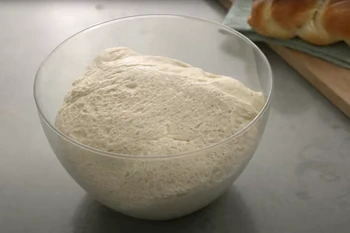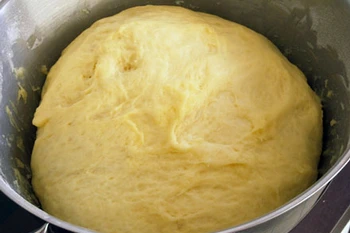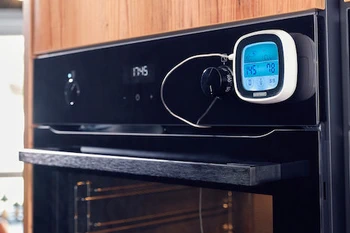To find out more...
Your oven in "proofer" mode

During proofing, the yeast ferments the sugars present in the dough, releasing carbon dioxide which forms bubbles.
This process allows the dough to swell and aerate, guaranteeing a soft, light texture when baked.
To facilitate this stage, many kitchen electric ovens are now equipped with a function called "étuve" or "pousse", which offers a temperature of around 40°C (104°F).
On paper, this function looks ideal, but in reality it can cause problems.
Why is 40°C (104°F) often too hot for good growth?
While the idea of the proofer is appealing - to accelerate dough growth by maintaining a constant temperature - it is ill-suited to the needs of yeast-raised doughs.

In bakery, the ideal temperature for proofing is between 25°C and 30°C. At this temperature, the yeast works efficiently, and the dough rises smoothly, without the risk of compromising its structure.
Unfortunately, the 40°C temperature commonly offered by oven proofer functions is too high.
It would appear that manufacturers have difficulty in maintaining very low temperatures (30°C) in their ovens.
At 40°C, the yeast can start to run out of steam, or even degrade, as it works much better in a milder temperature range, and this can affect the final texture of the dough, which will be less aerated.

But the problem doesn't stop there: for doughs containing butter, such as brioches, croissants or other viennoiseries, a temperature of 40°C can be downright embarrassing, as butter starts to melt at around 35°C. This means that at 40°C, the butter in the dough risks liquefying, compromising the flaky structure of your viennoiseries.
Instead of a homogeneous push, you could end up with a greasy dough that's difficult to handle, and a product that's ultimately less moist.
What to do?

First and foremost, check your oven's proofing temperature: Put a thermometer in your cold, switched-off oven, start it up in proofing mode, and read the temperature after 15 minutes.
You may be surprised by the reading. For example, I have a good 45°C in my oven, compared with the 35°C displayed by the oven!
If the measured temperature doesn't exceed 35°C, all's well, but if it's close to 30°C, it's just fine.
In these 2 cases, you can use your oven in proofer mode.
And if not, try one of the alternatives below.
What are the alternatives?
Here are a few simple solutions for creating an environment conducive to growth, without exceeding ideal temperatures:
- Alternate operation: Once your oven's proofer is at the right temperature, place your dough pieces in the oven, then turn off the oven. Check the temperature regularly (every half-hour or so) and restart the oven for a few minutes to bring it back up.
- Oven off with a bowl of water: Place a bowl of boiling water at the bottom of the oven when it's off. The steam slightly increases the temperature and humidity in the oven, creating the perfect environment for the dough to rise, usually around 30°C.
- Warmest room in the house: If you don't feel like using your oven, find a lightly heated or sunny room (like near a window or in a kitchen with appliances running).
- Turn your stopped oven into a mini-chamber by plugging in a small light bulb near your dough. See how to do this on this page.
- Slow growth: For a slower rise, let your dough rise in the refrigerator at 5°C for several hours (typically overnight). This longer process develops more complex flavors and improves the texture of your bread and brioche doughs.
In summary: Although the proofer function of some electric ovens is a practical option for accelerating dough growth, it is not always suitable, particularly as the temperature is too high, around 40°C.
To avoid compromising the texture of your breads and pastries, it's best to opt for gentler methods, allowing for more controlled and successful rising.
Butter vs. grease
We often read in a recipe where a pastry is put into a mould that, just before pouring, the mould should be buttered or greased. But what's the difference between these 2 terms?December 1st 20259705
Getting out of the fridge early
Very often when you're cooking, you need to take food or preparations out of the fridge, to use them in the recipe in progress. There's nothing tricky about this: you just take them out of the fridge and use them, usually immediately, in the recipe. But is this really a good method?November 24th 20251,1045
Who's making the croissants?
When you look at a bakery from the outside, you naturally think that in the bakery, the bakers make the bread, and in the laboratory, the pastry chefs make the cakes. It's very often like that, with each of these professions having quite different ways of working, but sometimes there's also one...November 23th 2025998
Oven height
When we put a dish or cake in the oven, we naturally tend to put it on the middle shelf, and that's what we usually do. But in some cases, this position and height can be a little tricky, so let's find out why.October 8th 20252,7265
The importance of sieving
In recipes that use a fine powder (flour, powdered sugar, etc.), you'll often see the advice to sift before using it. To sift is to pass the powder in question through a sieve (a very fine strainer) before incorporating it into your recipe. It's often advice, but is it really useful?September 3rd 20257,5273
The return of the "Norman hole"
You maybe know the "trou normand", this old gastronomic custom typically French which consists in taking a (small) glass of calvados, generally between the last course and the dessert? It's something that seems a bit anachronistic nowadays, having a glass of an alcohol of more than 60° in the...December 18th 202115 K4.8
What is the difference between bakery and patisserie?
This is a question that you may well have asked yourself and which I will attempt to answer. In France the two trades of "boulangerie" (bakery) and "pâtisserie" (patisserie and confectionery) have always been quite distinct, but where exactly do the boundaries lie? .February 7th 2017134 K 14.1
Drawing a pattern in pastry
Often in the kitchen, in pastry-making, or in baking, we need to trace a pattern on a pastry. It's just a question of aesthetics but it has its effect after baking on a galette, pithiviers, pâté en croute (terrine in a pie crust), etc.May 23th 201935 K4.1
Cleaning endives
If you buy your endives elsewhere than in supermarkets, and in this case the best is of course from a market gardener, he or she is the one who planted and harvested them, in this case you will have endives full of earth or sand, depending on where they were grown, which is normal and reassuring, we...March 24th 202026 K4.6
No need to boil gelatin
Gelatin is a magical ingredient for making light, creamy, structured desserts, yet it's often misused in the kitchen. A common mistake in some recipes is the idea that it needs to be boiled for it to work properly, but this is a mistake indeed: gelatin melts at a much lower temperature, around...November 21th 20248,2655









